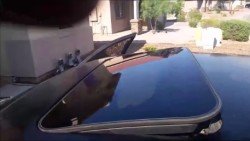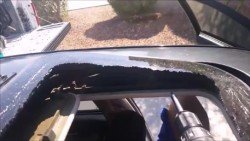

Sunroof Replacement
This blog is about another sunroof installation, this time on a 2008 Infiniti G35 4 door sedan. The usual is necessary and common with most sunroof glass for the past 2 decades:
- Clean as much glass up as possible before operating the sunroof in ANY direction.
- Remove covers on each inside to expose four to six torque screws that hold the glass in place.
- Unscrew these screws.
- Lift on each side evenly to prevent more glass from falling into work area.
- Vacuum some more, removing every piece of tempered glass from the work area.
- Place new glass in. Some sunroofs will have a little play in the sunroof’s bracket holes so don’t tighten completely.
- Typically, especially in aftermarket sunroof glass, you want one millimeter below flush in the front, and one millimeter above flush, then tighten and test operation.
Potential Sunroof Issues
To determine whether your car requires a sunroof glass replacement, look out for these key indicators:
Water Leakage: If you observe condensation or moisture buildup inside your vehicle, particularly around the sunroof area, it’s a sign that your sunroof might be leaking. This is often accompanied by water stains or a damp interior roof, and sometimes even a musty odor can be noticed before the actual leakage starts.
Visible Damage: Check your sunroof for any signs of breakage. Cracks or shattered glass are clear signs that your sunroof glass needs immediate replacement. Damage can occur from debris, such as rocks or branches, especially when driving at high speeds or during severe weather conditions.
Operational Issues: If the sunroof is not opening or closing smoothly, or if it is stuck, there might be a mechanical failure. Such problems generally require professional intervention to ensure the sunroof operates properly, preventing further damage or inconvenience.
If you notice any of these issues, contact a specialized auto glass technician who can provide a comprehensive assessment and handle the necessary replacement swiftly and safely.

